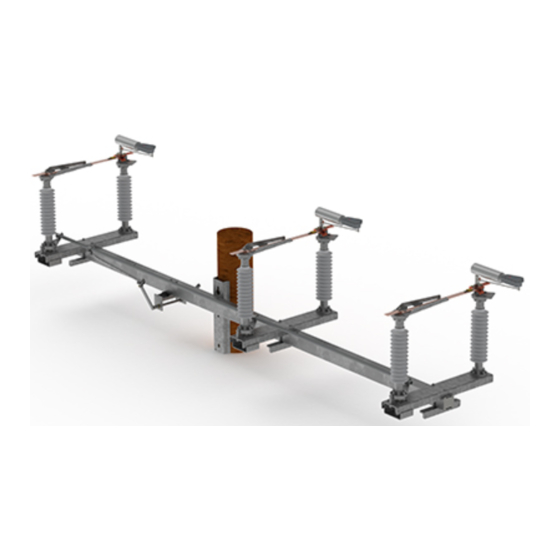
Table of Contents
Advertisement
Quick Links
The LineBOSS switch is designed to operate for many years without maintenance in most environmental
applications. However, there are service conditions or other causes for switch maintenance. The following
guidelines should be used for field service and maintenance of LineBOSS outdoor switchgear.
For additional information refer to ANSI C37.35 "IEEE Guide for the Application and Installation, Operation
and Maintenance of High Voltage Air Disconnecting and Load Interrupting Switches."
All installation documentation received in the switch-shipping container should be retained for future reference.
Replacement documentation is available from Inertia Engineering upon request.
Inspection & Maintenance:
o Control Mechanism:
Inspect operating handle and control rod guides to verify that they have not been damaged or bent
and insure that the operating handle mounting bolts have the proper torque (40-60 ft. lbs.). Replace
components that have been damaged. Fiberglass control rods should be replaced when excessive
"blooming" or exposed stringy fibers are observed as the insulation capability of the rod is
compromised when this type of degradation occurs.
o Switch Contacts:
Switch contact jaws and blades may require periodic lubrication in corrosive environments. Switches
that become difficult to operate should have grease applied to the top and bottom of the rotating
contact blade where it contacts the stationary contact jaws. The old contact grease should be
whipped clean prior to the application of new grease to the switch contacts. The contacts are "self
wiping" and will displace the new grease as required upon closing the switch.
Switch contacts are lubricated at the factory with "Mobile 28" corrosion preventative grease.
Chevron FM NLGI Grade 2 can also be used for switch contact maintenance. These greases are a
high performance, high viscosity greases that act as a lubricant and are water tolerant.
Switch contacts can be replaced, if required by ordering a replacement "single-phase kit".
o Switch attachments:
Arc horns:
Arc horns are non-spring, non-loadbreak stainless steel arms which should be visually inspected
for excessive wear at the interface between the stationary "pre-strike" arm, and the rotating blade
"pre-strike" arm. Any arm with less than one-half of its original diameter remaining at any point
should be replaced.
Arch Whips:
Arch Whips, or "Quick break whips" are Beryllium copper "spring" mechanisms which should
be inspected to ensure that the whip is properly engaged with the catch when the switch is in the
closed position. Whips should be replaced when 20% of the original length has eroded. Refer to
installation and adjustment procedures for original whip lengths.
AmpRupter and AmpVac loadbreaks:
Loadbreak interrupters should be inspected to ensure that the trip arm and catch arm are properly
latched when the switch is closed (refer to the proper loadbreak type installation instructions).
Interrupters that show signs of external arcing (black soot) on the external interrupter housing
should be replaced.
The only controlled copy is the electronic master. If you are reading this on a paper copy it is uncontrolled.
ENG-2026
LineBOSS Maintenance Instructions
Page 1 of 2
Rev: 1
Release Date:
04/28/2020
Advertisement
Table of Contents

Summary of Contents for Inertia Engineering LineBOSS
- Page 1 Release Date: 04/28/2020 The LineBOSS switch is designed to operate for many years without maintenance in most environmental applications. However, there are service conditions or other causes for switch maintenance. The following guidelines should be used for field service and maintenance of LineBOSS outdoor switchgear.
- Page 2 Page 2 of 2 ENG-2026 Rev: 1 LineBOSS Maintenance Instructions Release Date: 04/28/2020 Maintenance Intervals o Maintenance Intervals are ultimately up to the customer discretion. o Inertia recommends that each of the above listed inspection points should be done at each opportunity for a site visit –...
Need help?
Do you have a question about the LineBOSS and is the answer not in the manual?
Questions and answers